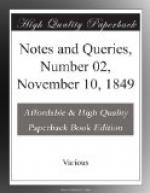There was a Sir William Skipwyth, who was appointed a Judge of the Common Pleas in 33 Edward III., and Chief Baron of the Exchequer in 36 Edward III.; and, were it not that Collins, in his Baronetage, followed by Burke, says that he remained Chief Baron till 40 Edward III., in which year he died, I should have had no doubt that the Irish Chief Justice was the same with the English Chief Baron.
The same authority adds that Sir William Skipwyth who was made a Justice of the King’s Bench [it should have been of the Common Pleas] in 50 Edward III., and who resigned his office in 11 Richard II., was the eldest son of the Chief Baron. But that authority does not make the slightest allusion to the appointment of the Chief Justice of Ireland.
A suspicion that this last Justice of the Common Pleas is not only the same person as the Chief Justice of Ireland, but also as the Chief Baron of the Exchequer, has arisen in my mind for the following among other reasons.
1. Collins and Burke are wrong in saying that he remained Chief Baron till 40 Edward III. His successor in that office was appointed on October 29. 1365, 39 Edward III.
2. They are further wrong, I imagine, in saying that he continued Chief Baron till his death: for Joshua Barnes, in his History of Edward III., p. 667., says that Skipwyth and Sir Henry Green, the Chief Justice of the King’s Bench, were in 1365 arrested and imprisoned on account of many enormities which the King understood they had committed against law and justice; and this relation is corroborated by the fact that Green’s successor as Chief Justice was appointed on the same day as Skipwyth’s successor as Chief Baron.
3. No proof whatever is given of the Chief Baron’s death in 40 Edward III.
I will not trouble you with other grounds of identification which occur to me: but as an answer to my question might “make these odds all even,” I sent the “Query” to the “Lost and Found Office” you have established, in the hope that some stray “Note,” as yet unappropriated, may assist in solving the difficulty.
EDWARD FOSS.
November 5. 1849.
* * * * *
THE THISTLE OF SCOTLAND.
Mr. Editor,—May I ask if any of your contibutors could inform me in an early number, when and on what occasion the Thistle was adopted as the emblem of the Scottish nation? I have looked into many historians, but as yet found nothing definite enough.
R. L.
Paisley, Oct. 29. 1849.
* * * * *
CAPTURE OF THE DUKE OF MONMOUTH.
Mr. Editor,—Having noticed the letter of Mr. John Bruce, in your Miscellany, I beg leave to inform him that the ash tree under which Monmouth was taken is still standing on the Woodland estate, now the property of the Earl of Shaftesbury.
I shall be happy at some future day, if it suits your purpose, to collect and send you such particulars as may be gained on the spot respecting it, and the incidents of the capture.




